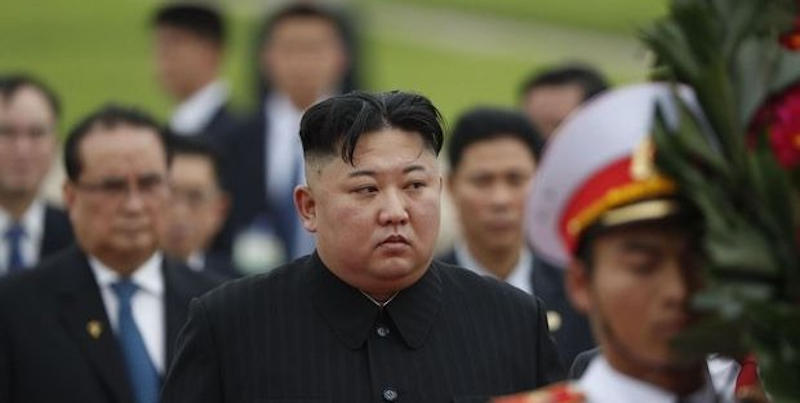In the Korean TV series Kingdom, broadcast on Netflix, an evil pregnant queen hatches a daring plan to get her baby to the throne, replacing the actual heir. The king in fact has died before the delivery of her baby, who would rule only if born before the demise of the old man. So, the queen keeps the husband “alive” by turning him into a zombie.
To hold on the deception, only few trusted aides have the privilege to see the zombie king, and everybody assumes he is still normal and going about his businesses, while the affairs of the state are firmly in the hands of the regent queen and her father, the high minister.
Yes, the queen and the high minister are cheating the court and the actual heir. But there is something deeper at play here. In this situation, being a zombie, is the king actually dead or alive in a medieval Korea where the person of the ruler is as holy as a god?
The actual heir feels guilty and remorseful when he chops off the head of his progenitor although he is just a flesh-eating raving monster. Other officials are less worried about this “killing.”
The story perhaps could be a good explanation for the difficult situation of present North Korea, where its paramount leader Kim Jong-un, the third of his dynasty, has disappeared for three weeks without too many explanations and then reappeared. He may be brain dead, held in a vegetative state, or it may all have been just a lengthy ruse to get some global publicity.
On May 1, the official North Korean news agency published photos and videos of Kim, smiling and fatter than ever, suddenly resurfacing while cutting a large red ribbon at the opening of a new factory. Around him there were a couple of dignitaries and his sister 32-years-old Kim Yo-jong.
Then had his rumored death all been a trick to draw attention to the man while the world was distracted by the global virus? In fact, North Korea is so secretive that there is no way of easily believing it now.
Kim’s reappearance could be a hoax to cover for his enduring sickness, or to give more time for a bitter power struggle being fought around his death bed; the photo could have been taken any time. In fact, if North Korea wanted to prove conclusively to the world its leader is alive, why didn’t it show footage of him with a May 1st daily in his hands, attesting to his well-being? Even in that case, the man in the pictures could still be a double, as Kim, like many heads of state, allegedly has many doubles, but at least it would be more “solid” than a couple of photos without any time reference.
Furthermore, North Korea fired gunshots hitting a South Korean guard post on May 3 inside the Demilitarized Zone separating the two countries. South Korean soldiers fired back. The quirk accident had no clear explanation. The same day the office of South Korea’s presidency said it believed Kim did not have surgery. US President Donald Trump said he is happy to see that Kim is alive and well.
In the next few days and weeks, we shall see better what has happened of the young Kim.
If he is well, Pyongyang will have proven it is riskier than ever, secretive over very sensitive news for the world (the health of its leader), or ready to leak fake news and stoke fears in order to come into the limelight in the middle of one of the worst global crises in decades – the ongoing pandemic. That is, North Korea, with its missiles, its nuclear capabilities, and its totally unscrupulous approach to international politics once again shows it is some kind of a cancer in the middle of an already unstable global order. This will pose new sets of priorities, because similar stunts could be easily repeated in the next months and years as the standoff between the US and China is likely to become more tense.
In a normal world, with a normal country, it would be fairly easy to inquire about the health conditions and the absence of a head of state. But North Korea is no normal country, and Kim Jong-un is no normal leader. This is the weirdest thing.

L’immagine accredita Kim Jong-un all’inaugurazione di una fabbrica di ferilizzanti a Sunchon (Corea Nord) il 2 maggio 2020
Kims never die
On the other hand, the issue is, even if he is indeed brain dead, Pyongyang may still not recognize it as such. This may not be actual medical science. Certainly, in every secretive regime the leader is not dead until he is pronounced so by the political authorities. But in North Korea it goes a step further. Is Kim really dead or alive according to Korean political culture? The answer is not so obvious, and even less so are its political consequences.
The founder of the dynasty ruling the communist hermit kingdom, Kim Il-sung, the first of the dynasty, deceased in 1994, is named “eternal leader” of North Korea. His powers were passed on to his son and successor Kim Jong-il, the second of the dynasty, who also became “eternal leader” after his demise in 2011.
Kim I got himself the title of president of North Korea in 1972. The title was left vacant and not passed on to Kim II in 1994. Four years later, after an opportune period of mourning, the filial son abolished the office of presidency and declared Kim I “eternal president”. It was the official establishment of a “theocratic state” based on much more than the cult personality of the founder. It was the “supreme leader absolutism”.
In this «the supreme leader is greater than the state, as the latter depends on the former… North Korea displays all the trappings of fundamentalist theocracy. The leadership cult in the North Korean system is different from the cult of Mao or Stalin, surpassing them not only in persistence, intensity, and grandiosity but also in the stress of “the blood vein for the continuation of the revolution” from generation to generation», argue Ashley J. Tellis and Michael Wills.[1] In 2016, the Constitution was amended again and the title was extended also to Kim II.
The system is more than an ideological concoction to ensure the power of the dynasty: it’s a religion, a cult believing that Kim I and II still have power and are “active” in a shamanic way in the lives and actions of the court in Pyongyang.
This sits fully well with old Korean folklore. South Korea is full of weird religions and cults, preaching tenets that sound very strange to unaccustomed ears, and northeast China, the old Manchuria and close culturally to Korea, has always been a hotbed of sects and shamanic religions. Li Hongzhi, founder of the pseudo-Buddhist religion Falun Gong, which had threatened the Beijing government in 1999 with a massive demonstration, hails from this region. They all inherited traditional “muism” 巫教(“religion of magicians” in Chinese) practices, whose worship and shrines were torn downin the south, where they “migrated” to pseudo-Christian beliefs, and in the north where they were clearly absorbed by the ruling elite.
If then the dear departed father and grandfather are still “alive”, how can the young king Kim III, whose heart is still throbbing although the encephalogram is flat, be dead? From here spawns a whole crowd of “theological” issues. The throne should go in theory to one of Kim III’s sons, but they are too young (allegedly 10 and 8). Would Kim’s sister be allowed to be the regent until one of the kids turns 21? But this would strip the Democratic People’s Republic of Korea of its last socialist vestige and turn it completely into a cultic esoteric monarchy.
Conversely if the “throne” is handed out to Kim Pyong-il, 65, half-brother of Kim II, how would this square with the linear blood succession route? Where would Kim III be put? Also, if the uncle takes over, would the brain-dead nephew still be officially alive or would he be definitely gone? And what about Kim III’s tenure? And wouldn’t the official theocracy be watered down?
That is, with Kim Pyong-il the dynasty would move slightly out of the wacko monarchy orbit and more back to an old-fashioned communist dictatorship. What would be best? One wonders!
Of course, this was the case if Kim III were dying, now that he is well all of these are moot points. Or not, because they still linger over the hermit kingdom and its delicate position as buffer or trigger of clashes between China and the “western world”.
How did we get here?
Yet before moving forward with the delicate international implications of all this bizarre and confusing fog of political/religious notions, perhaps we should take a step back to see how we got here.
The shamanic ever-living Kim Il-sung started off as a communist in the Chinese Communist Party in what was Japanese-controlled Manchuria and Korea. He was brought to power when the Soviet Red Army stormed the region in the last days of World War II, splitting the peninsula in two. Kim in 1950, at Russia’s behest, attacked the south, but after some initial successes was pushed almost all the way back to the Yalu river, the border with China.
It was a pivotal moment for China. Mao was then reluctant to support North Korea. He’d rather move to definitely eliminate his mortal rival, the KMT leader Chiang Kai-shek, who had run to the sub-tropical island of Taiwan. The US had not intervened in China when the communists contravened the agreement and crossed the Yangtze River, which should have split the country into a communist north and a nationalist south. Washington was apparently still uncertain about its course of action with Mao. China pundits in the US argued over whether Mao was a real communist or a closet pro-American force.
Perhaps if Mao left Kim to his destiny, the US would not intervene if the communist tried to land in Taiwan. Yet perhaps the difficult Taiwan invasion would fail and Mao would be left without the island and without a foothold in Korea.
The Soviets then pushed Mao hard. They had armed and equipped the communists who fled to Manchuria, and the communists won the civil war with Russian weapons and Russian military advisers. Gao Gang, the mighty Chinese communist proconsul in Manchuria, was devoted to the Soviets and afraid the troops led by US General Douglas McArthur, a stern anti-communist, would cross the Yalu River and “liberate” China from the communist vise. The decisive argument in the Chinese Communist Party was that it was more dangerous to have US troops on the land border in Manchuria than to have them across the sea in Taiwan. China therefore decided to support Kim. It sent troops into Korea and managed to push the Americans back to the 38th parallel.
The communist regime in Pyongyang was then propped up by Russians and Chinese. Following the Sino-Soviet split in the 1960s, Kim, a very clever operator, managed to hold the two allies in balance. In the 1970s, when Russia and China had come to blows on the Ussuri, close to the North Korean border, and Beijing was helping supply US weapons to the Mujahideen fighting the Soviets in Afghanistan, Kim wriggled between the two old friends, both keen on keeping tabs on Pyongyang.
Mao died in 1976 with a messy succession culminating in the arrest of the Gang of Four. After all, Stalin’s succession, in 1953, had also been a mess. So, things could be in North Korea. Kim Il-sung, born in 1912, though much younger than the Great Helmsman, had to prepare for the choice of his heir, which had to be done in a clean manner to avoid power vacuums, hazardous for both allies at odds with one another.
In the power struggle between different factions, pro-Chinese or pro-Russian, in Pyongyang, it was easier to sell the idea to Moscow and Beijing that choosing a son would be less knotty. Two half-brothers were vying for the privilege: Kim Jong-il, the elder, born in 1941 or 1942; and the younger Kim Pyong-il, born in 1954. In 1979 Pyong-il was sent to be an ambassador in Eastern Europe, and in 1980 Jong-il assumed the official role of heir apparent. This set a fundamental precedent.
In the early 2000s, the issue of the choice of the succession of a Kim “royal” presented itself again. Russia, suffering after the fall of the Soviet empire, had no resources or interest in getting involved with prickly North Korean affairs. In fact, since the mid-1980s China had become practically the only external economic and political support for the flailing regime in Pyongyang. As Jong-il had 14 years to suit himself into the job of state leader, he wanted his heir to also have enough time to do the same and needed Chinese support for that. Jong-il wanted his first son to be the heir. Yet Kim Jong-nam, born in 1971, in 2001 was embarrassingly caught at the Tokyo airport with a forged passport, a bag full of cash, his 4-year-old son, and two mistresses.
The Chinese, holding the purse, were then engaged in the six-party talks with the US, and wanted to move Pyongyang in a different direction. The US was supportive, and so was South Korea, then committed to a policy of warming up to the North. Beijing wanted Pyongyang to drop hereditary succession.
They pressed Jong-il for this. But he resisted. By then North Korean top echelons were stuffed with Kim’s uncles, in-laws, and siblings of all shapes and forms. They all had a vested interest in carrying on a bloodline that would guarantee also their future position. A successor with no blood ties to the ruling Kim family would endanger the stability basically of the whole North Korean leadership, and the family would fight for its political survival.
In this situation, the Chinese managed to wrest a compromise: Pyongyang dropped Jong-nam for his younger brother Jong-un, who looked so much like his grandfather. In 2010 Jong-un was made heir apparent, and the year after he took over when his father died. Yet he may have felt his power was not too secure since he thought it necessary to allegedly kill his half-brother, self-exiled in Malaysia in 2017. It was ugly, but after all there was little beauty in Pyongyang’s politics, so the world thought it should live with it, as Jong-un, born in 1984, would be around for a long time.
The China Card
On April 12th, Kim visited an air base, and on the 14th he was supposed to be at a weapons test but didn’t show up. Most importantly, on the 14th he was expected to attend the official celebration of the Day of the Sun, the most important public holiday in North Korea, but was absent.
Unexplained absences are not strange occurrences in North Korean politics. There have been many similar instances in the past.[2] But on April 20th the South Korean newspaper NK Daily wrote a detailed article saying Kim III had undergone cardiovascular surgery and his condition was very serious. A few hours later, two Twitter accounts parodying CNN and the American Attorney General William Barr claimed that Kim was brain dead. Following these tweets from America, heads started spinning in Beijing. Chinese officials had become extremely anxious. The lurking sentiment in the following days in Beijing was that the United States was in the loop about developments in Pyongyang and that Washington was somehow pulling the strings in favor of Kim’s younger sister, Kim Yo-jong, also trusted by the brother.
This was extremely grim for Beijing because, for the first time ever, Washington was making inroads in North Korea. Yo-jong is young, female, and Western-educated. She was therefore a likely sell to American and Western media about a new North Korea, no longer aligned with the old world. This idea might not be feasible because elderly officials and generals, twice the age of the young lady, would hardly listen to the girl, unless she becomes the puppet of a power faction in Pyongyang.
In any case, Beijing would rather favor an old choice, Kim Pyong-il, half-brother of Jong-il, who had spent 40 years of his life being a North Korean ambassador in Eastern Europe, and therefore was fairly removed from a more direct American influence. Pyong-il would have the extra advantage of being older, and of an older generation. Therefore, he could be more amenable to many of Pyongyang’s top officials and perhaps to revamp Beijing’s old ties.
Now that Kim has apparently resurfaced all of this will be important. After this showdown around Kim III health, will his uncle Pyong-il also disappear to secure sister Yo-jong’s position, as it happened with his half-brother Jong-nam in Malaysia? Then, if Kim Jong-un is alive and healthy, will his uncle Kim Pyong-il, who challenged his father and possibly his sister, be alive for long?
The moving strategic backdrop
Yet, China’s big issue here is the broad strategic concerns over Washington tiptoeing into Pyongyang’s decision-making arcana. This could change many things for China in its wide tussle with America.
Forty years ago, China attacked Vietnam with the blessing of the United States because Vietnam had invaded Cambodia and threatened to push over to Thailand. Vietnam was a strong ally of the USSR at that moment, and China was siding with the United States in the ongoing Cold War.
Forty years later, China sees that the United States is supporting Vietnam in a joint effort to contain Beijing, and both appear quite oblivious to the very hot war they fought with one another in the 1960s and 1970s.
Since last year, Hong Kong and Taiwan are slipping away from China. Taiwan is drifting out of Beijing’s orbit, and it seems harder to get it back in line with every passing day. Beijing’s dream of reunification with the island, de facto independent and de jure part of one China, seems harder to realize. Taiwan is gaining greater diplomatic recognition and more open American and Japanese support for its slow but constant drift away from China. Lastly, its success in effectively stemming the epidemic without compromising its democratic structures makes it an international example of how one can fight the virus without the draconian measures adopted in the People’s Republic of China.
At the same time, protests in Hong Kong are changing the social, political, and economic environment of the territory. With every passing day, Beijing seems in the clasp of a conundrum.
If it holds control of the territory, it has to sacrifice the social and political freedom of the territory.Therefore it makes Hong Kong less amenable to foreign finance, and undermines its value as an independent stock market. Hong Kong could then stop being the prized safety valve between the closed Chinese economic system and the open global economic system.
In China, there is no free exchange of capital accounts, which is available both in the developed world and in Hong Kong. Losing Hong Kong as a bridge for free exchange of capital accounts for Beijing means that every interaction with global finance and the economy will become more cumbersome and difficult.
Yet, Beijing can afford even less to lose control of the territory and make it the springboard of possible revolution against the Communist Party in China. This is the fear of the spreading protest in the territory: it will move out of Beijing’s control and encourage rebellion in China. Then in order to avoid Hong Kong becoming the hotbed of a Chinese revolution, Beijing needs to quash most of what makes the territory a valuable international stock exchange: freedom, peace, et cetera. The result is that business from the Hong Kong market is moving to other markets in the region and worldwide.
Moreover, the deadly coronavirus has been ravaging the country and the whole world. Production and consumption have drastically slowed down for the past three months. Now production is picking up, but internal consumption is suppressed because there are still measures to contain the possible infection domestically, and consumption worldwide has collapsed as the whole outside world has been barricading indoors for the past few months.
A huge world-wide depression is stalking in. It could be the deepest in the history of capitalism, and nobody’s clear about when the virus will be defeated with a cure or a vaccine, or when the depression will be overcome.
Economist Nouriel Roubini lists ten risks making this ongoing crisis deeper than ever. «These 10 risks, already looming large before Covid-19 struck, now threaten to fuel a perfect storm that sweeps the entire global economy into a decade of despair».[3] In 1929, it took the world about ten years to come out of the depression, which actually ended with World War II.
Moreover, a number of cases have been brought against China in American courts, claiming damages for the spread of the virus. A number of countries and associations are asking for trillions of dollars in reparations. It’s impossible legally that the courts, and their sentences condemning China whenever they come, will force Beijing to pay US $20–30 trillion two or three times its GDP.
But a public campaign for damages against China could build up a wide political atmosphere that could push governments in the United States, Europe, and Japan to renege on their debts to Beijing. China has about US $3 trillion in reserves, mostly in treasury bonds from the US, Europe, and Japan. If they forfeit this debt, claiming it is only a portion of what their countries are owed as reparations for the damage of the virus, China could be left with little money in its pockets. With negligible foreign trade, because of the decoupling, and without most of its reserves, China could have internal problems with its investments, and huge trouble in paying for its imports of oil, raw materials, and grains, which are necessary for its development and also its survival.
Even besides these cases, reportedly the US administration is studying retaliatory measures against China for hiding facts about its coronavirus.[4] And after all the dramatic US-China standoff created the conditions for the pandemic, not the other way around.[5]
Against this backdrop, the picture is of the US setting China under siege. Then possible American inroads, even in North Korea, would make China extremely nervous.
This could bring to fruition the nightmare of the Chinese communists in 1950, when they were afraid to have American troops on their land border. Furthermore, it could open new issues. There are about 2.5 million ethnic Koreans in China. Some groups from South Korea in the past have claimed chunks of China’s northeast, saying it is a historic part of old Korea. But the claims are void simply because there is no land border with China. A different government in Pyongyang could raise these issues, bringing new elements of friction between China and one of its neighbors.
In all of this, China is pretty much alone. Russia, an old player of the Korean game, is mostly out of the picture. With the price of oil being virtually negative, Russia is getting poorer by the day. Russian oil production costs are about $40 a barrel. This means that Russians are wasting $40 a barrel every day to get oil that nobody buys and they’d rather not store. In fact, in the past few weeks, they’ve started burning oil to at least save on storage costs. It’s impossible to think that they would shut down the wells, because to reopen oil production would be extremely costly. But, with these conditions, in a few months, Russian reserves in hard currency could be depleted just to pay for the upkeep of its oil industry.
If this situation carries on for a few months, it will be like a war of attrition for China. Seventy years ago, the Cold War was actually started with a very hot war in North Korea. Now, there is no immediate danger of a hot war on the Korean peninsula. However, some Chinese hacks may wish for a military intervention in North Korea to push American meddling away and regain full control of Pyongyang with the support of some local pro-Chinese generals. The stakes are extremely high, and Beijing is very nervous.
This sounds like a lose-lose proposition to Beijing. If Beijing intervenes in North Korea, it may regain Pyongyang but then a huge political vise would close on the country, hastening the pace of the ongoing decoupling between China and the world.
If Beijing doesn’t intervene and Pyongyang swings even by a few centimeters toward the United States and South Korea, this could make Beijing very uncomfortable.
China would need a new overall strategy to get out of the corner where it feels pushed harder and harder every day. We shall see if new ideas will come out at the end of the month at the National People’s Congress meeting. Here the issue won’t just be China itself. Many Chinese wonder whether the US will withstand the lashes of the pandemic and how. The perceived lack of US global leadership doesn’t simply show that America is faring poorly worldwide, but also that it may be losing direction in its fight with the virus and the economic depression at home.
The pandemic, the majority of experts agree, won’t peter out in a few weeks. It will stay with us for months, until a vaccine or a cure are available. This could happen sometime next year. It will take a few more months to get everyone vaccinated, and more time to calm people down and convince them to restart life like before. The real horizon for the beginning of the recovery from the epidemic is early 2022.
That is, it will be a long and difficult haul to get the US on its feet again and recover its role as global leader. In the meantime, the US may go bust, and China’s resilience may save the day.
[1]Domestic Political Change and Grand Strategy (2007), 128.
[2] See also SettimanaNews.
[3] See The Guardian.
[4] See The Washington Post.
[5] See SettimanaNews.





